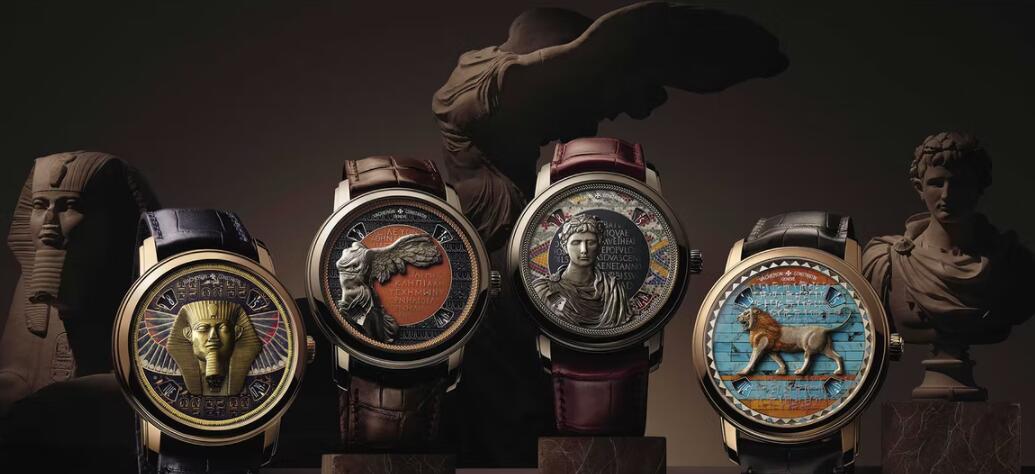
Vacheron Constantin Métiers d’Art Tribute To Great Civilisations

The new Vacheron Constantin Métiers d’Art collection, Vacheron Constantin Métiers d’Art Tribute To Great Civilisations, is not for everyone. Quite literally – each of the four new watches is a limited and numbered series of five. Five! So if this is your thing, and you’re lucky enough to have the bankroll, you’ll want to move quickly.
The series was designed in close collaboration with the Louvre, and each watch references a piece in the museum’s collection of antiquities – the Grand sphinx de Tanis, Lion de Darius, Victoire de Samothrace, and Buste d’Auguste.
Each 42mm watch in the collection employs a different craft technique that reflects the nature of the art that inspired it. Vacheron’s stable of artisans packed incredible details into limited space, a not-unfamiliar brief for the brand’s Metiers d’Art collection, but one that I doubt gets easier with time.
Each watch is powered by VC’s self-winding Manufacture Caliber 2460 G4/2. The hours, minutes, day, and date are shown in apertures around the edge of the dial, and the conspicuous absence of hands gives the artisans as much use of the dial as possible. Each watch features an engraving of era-related text on the sapphire, adding both physical and conceptual depth.
The Great Sphinx de Tanis, believed to be from Egypt’s Middle Kingdom (circa 2035 to 1680 BC), has been in the Louvre’s collection since 1826. The watch’s blue-black enamel dial is adorned with elements inspired by a necklace depicted on the coffin of ancient Egyptian astronomer and scribe Nakht-khonsou-irou. Flanking the hand-engraved sphinx found at the center of the dial, the necklace features champlevé enamel petals, some purposefully aged (an incredibly high-end faux patina of sorts). The sapphire crystal features hieroglyphics of the text, “The king of Upper and Lower Egypt Ba-en-Ra-mery-Amon. The son of Ra Merenptah who is satisfied with the Ma’at, endowed with eternal life,” in metalized engraving.
The Lion de Darius was found on the Frieze Of Lions in the courtyard of the palace of Darius the Great in Susa, in what is now southwestern Iran (559 – 330 BC). To capture the texture of the Frieze, the watch was created using stone marquetry, a technique where patterns are formed and assembled with stone fragments. Incredibly time-consuming and fragile, it’s a technique not often found in watchmaking. The watch also features engraved metal and champlevé enamel inspired by the Frieze of Archers and, of course, an enameled lion.
One of the Louvre’s most recognizable pieces, the Victoire de Samothrace (also known as the Nike of Samothrace or Winged Victory) is a statue from Hellenistic Greece of the Antigonid dynasty (277 – 168 BC). The watch it inspired features a deceptively simple brown dial that, in fact, required six firings and a mix of discontinued enamels, and grisaille enameling on the outer dial in the style of Greek vases. The sapphire features “a list of Athenian initiates to the mysteries of the Great Gods of the island under the guidance of a certain Socrates.”
The dial of the Buste d’Auguste piece pays tribute to the bust of Octavian Augustus, from The Roman Empire of the Julio-Claudians. Taking cues from the bust of the breastplated emperor, the watch uses a mix of carved gold applique for the figure and enameling and stone micro-mosaic for the dial. More than 660 stones were used to craft the mosaic motifs, inspired by a fourth-century mosaic found in Lod, Israel, on the outer periphery of the dial. A second mosaic, found in Tunisia, inspired the patinated white-gold outer frieze.
The Vacheron Constantin Métiers d’Art Tribute To Great Civilisations sheer fact that these pieces look as dynamic and interesting as they do in photos is astounding. The collaboration could have veered quickly into museum gift-shop territory (and I do love a museum gift-shop aesthetic, just not for a six-figure price tag) but instead, we see four painstakingly crafted watches that balance literal sources of inspiration with art- and era-related works. The result is horology as art itself.